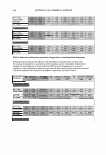324 35 1t1 C - 0 3 111- .. • .! .J'C7,5 e -= g -� 2 (/) .. a, • 1.5 Iii e :i 1 • II) 0 o.5 45 H 4 t j 3.5 .J .t:: et 3 g � 2.5 (/) &l £ 8 1.5 ... 0 1 0.5 35 GI 30 • a, ...I C rs 25 oS (/) (/) 20 tJ .5 ,SI GI s:. 0 ·? e ,s g & ii: 10 I! 'o JOURNAL OF COSMETIC SCIENCE A Baseline 30" B Baseline 30' C Baseline 30' 5' 15' Time of Evaluation 15' Time of Evaluation 5' 15' Time of Evaluation 60' 60' 60' + Liquid makeup +Shampoo +Babywash * Eye makeup remover +Mascara + Powder eye shadow +Facial cleanser 120' 24h 120' 24h 120' 24h Figure 5. Average score levels of ocular irritation at post-instillation evaluation intervals. staining than the remaining product types, in which mascara exhibited the lowest correlation between subjective response and objective irritation. Epithelial defects of the ocular surface were observed at later post-instillation evaluations, compared to the subjective responses and objective irritation, in which facial cleanser, shampoo, baby
ASSESSMENT OF OCULAR IRRITANCY 325 Table III Correlation Coefficient (r value) of Fluorescein Staining Between Categories Liquid Baby Eye makeup Powder eye Facial makeup Shampoo wash remover Mascara shadow cleanser Liquid makeup 1.00 Shampoo 0.92 1.00 Baby wash 0.91 0.95 1.00 Eye makeup remover 0.94 0.88 0.82 1.00 Mascara 0.85 0.88 0.77 0.97 1.00 Powder eye shadow 0.88 0.92 0.99 0.77 0.71 1.00 Facial cleanser 0.92 0.95 0.98 0.79 0.71 0.98 1.00 wash, and powder eye shadow elicited the most similar fluorescein staining patterns at post-instillation intervals. Human ocular instillation is an effective and safe in vivo methodology for the assessment of cosmetic irritancy. Ocular irritation elicited by the evaluated test materials varied markedly by product category, with respect to the type (subjective reports, inflamma tion, and fluorescein staining), duration, and ocular tissue involvement, demonstrating that these factors are important considerations for the prediction of the ocular irritancy of a test material. ACKNOWLEDGMENT The authors acknowledge Julie R. Meyers for her valuable assistance in writing this paper. REFERENCES (1) N. E. McCain, R. R. Binetti, S. D. Gettings, and B. C. Jones, Assessment of ocular irritation ranges of market-leading cosmetic and personal-care products using an in vitro tissue, Toxicologist, 66 (1-S), 243 (2002). (2) P. A. Jones, E. Budynsky, K. J. Cooper, D. Decker, H. A. Griffiths, and J. H. Fentem, Comparative evaluation of five in vitro tests for assessing the eye irritation potential of hair-care products, Altern. Lab. Anirn., 29, 669-692 (2001). (3) Y. Gao and B. E. Kanengiser, Observation of ocular irritation in human subject, IOVS, 41, 5257 (2000). (4) J. D. Burdick, Y. Gao, B. E. Kanengiser, J. C. Merrill, and J. W. Harbell, Comparative assessment of two eye area cosmetic formulations through evaluation of alternative eye irritation methods relative to endpoints measured in a human clinical sub-acute study design, Society of Toxicology 2003 Annual Meeting. (5) J. H. Draize, G. Woodward, and H. 0. Calvery, Methods for the study of irritation and toxicity of substances applied topically to the skin and mucous membranes,]. Pharrnacol. Exper. Therapeutics, 78, 458-463 (1944). (6) J. S. Friedenwald, W. D. Hughes, and H. Hermann, Acid-base tolerance of the cornea, Arch. Ophthal rnol., 31, 279-283 (1994). (7) U.S. EPA, Primary eye irritation study in pesticide assessment guidelines, subdivision F hazard evaluation: Human and domestic animals, EPA Guidelines 1982, 51, 81-84 (1982). (8) U.S. EPA, Toxic substance control act test guidelines, part 798: Health effect testing guidelines. Subpart B-General toxicity testing, Fed. Reg. 1985, 50, 39398.
Purchased for the exclusive use of nofirst nolast (unknown) From: SCC Media Library & Resource Center (library.scconline.org)






































































































